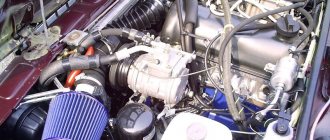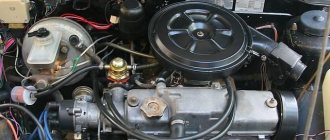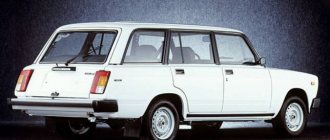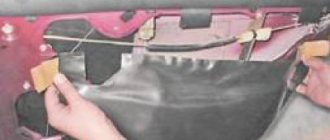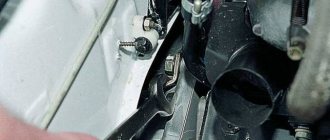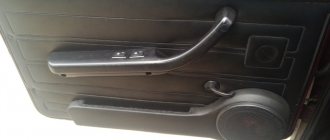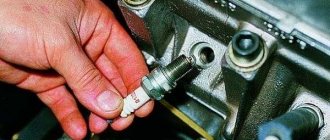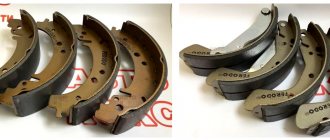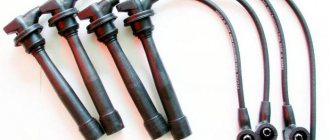The turbine on the VAZ 2107 is considered exotic among car enthusiasts. And the power advantages of turbo engines over their factory counterparts are driving the proliferation of passenger cars equipped with turbines. And not only among foreign cars...
In theory, their main goal is to achieve maximum horsepower. For fans of fast driving, this is the main argument for sure. Given the same displacement, a turbocharged engine is characterized by almost double power with standard fuel consumption. In modern conditions, small-displacement turbo engines are very relevant.
Turbocharging VAZ 2107
The conventional division of the turbine provides for 2 groups:
- With low pressure up to approximately 0.2-0.4 bar.
- With high pressure up to 1 bar and above.
Installing a high-pressure turbine requires significant modifications to the engine, and when installing a low-pressure unit, almost all factory elements of the system can be preserved.
Visual installation
A sample with a low-pressure turbine and a VAZ 2107 engine with distributed injection involves the use of the following factory parts: cylinder block, crankshaft, connecting rods, camshaft and valves. The difference in additional components is associated only with the pistons and cylinder head due to the need to reduce the compression ratio during installation. This functional feature is achieved by enlarging the combustion chamber or special pistons. However, there is a theory that the pistons can be factory pistons and you can limit yourself to replacing the head.
The injector output also differs. The turbine fills the space between the exhaust pipe and the exhaust manifold. The factory model remains the resonator and muffler. If you need to obtain more power, still use the recommendations for installing a direct-flow exhaust. Injection requires an enlarged receiver and a non-standard control program. The lubrication system also undergoes minor changes. Summarizing the above, we can conclude that the turbine itself will be the most expensive and scarce part.
Advantages and disadvantages of combined supercharging
The undoubted advantage of combined supercharging is the absence of the “turbo lag” effect. The engine begins to produce its Newton meters almost from idle. This is necessary not only for those who like to “light up” at a traffic light, but also helps a lot in traffic jams, helping to easily move away without spinning the engine.
However, there are still more negative aspects. First of all, this is the high cost and complexity of production. And in the event of a breakdown, you will have to pay a considerable amount at a car service center. Moreover, the turbine, mechanical supercharger, electromagnetic clutch, drive belt and pipes take up a lot of space under the hood. This makes maintenance extremely difficult. And even if minor repairs are necessary, literally half the car has to be disassembled.
Principle of operation
Why is it that the turbine attracts vehicle owners to the injector? Everyone knows the fact that the volume of fuel that burns out in the cylinders is closely related to the amount of air absorbed into the middle of the engine when starting up by the injector. And the fulfillment of the mass ratio condition, numerically expressed as 1 kg of combustible mixture to 15 kg of air, is mandatory. After all, subsequent enrichment of the liquid implies a decrease in power. In order to remove this obstacle, the cylinder requires more air supply by pumping it into excess pressure. Thus, an increase in air pressure by 30% triggers an acceptable increase in power and acceleration dynamics.
The fundamental features of the operation of a gas turbine-type compressor on an injector are elementary. Its body is fixed to the exhaust manifold. In the middle of the unit itself there is a turbine wheel connected to a compressor wheel. The operation of the exhaust gas stream provokes the spinning of the turbine. Then, using the shaft, the torque is transferred to the impeller of the compressor sample, which sucks in air through an air-type filter and transfers it to the carburetor under pressure, thereby increasing the saturation of the cylinders.
Thus, the same volume of cylinders pumps a larger amount of working mixture. A regular VAZ 2107 engine is characterized by 25 percent combustion of the fuel pumped into the cylinder due to lack of oxygen.
An increase in air filling implies a uniform increase in fuel combustion. This factor affects the increase in engine efficiency. As a result, a gas turbine supercharger allows a larger volume of fuel to be pumped in the same period of time. Torque characteristics also increase, affecting acceleration dynamics.
Misconceptions when choosing a compressor. Performance and pressure
There are several misconceptions and myths that come up when purchasing a compressor. 20 years of experience at pnevmo.ru has shown that many customers have difficulties even with the basic parameters of the compressor: capacity and pressure. For example, what is compressor capacity?
Logically, it is clear that this is the amount of air that the compressor pumps per unit time. What is the suction capacity of piston compressors? In our opinion, this is a theoretical performance that is defined as the product of the cylinder volume (piston area multiplied by the piston stroke) and the crankshaft rotation speed. It is quite different from the real one, often overestimating the value by 30%. 40% By the way, one of the most honest compressor manufacturers is the Bezhetsk plant ASO, which, unlike others, publishes real performance values.
How to check the performance of a piston compressor? It is logical to assume that you need to take a stopwatch and time how long it takes the compressor to pump up the empty receiver
I draw your attention to the word empty - water always settles in the receiver and if it is not drained, the results will be overestimated. Next: the water is drained, the stopwatch is ready, we turn on the compressor and note the time... and we get the wrong answer. The fact is that if the compressor pumps receiver up to 10 bar, then it will pump up to 1 bar quickly, up to two a little slower, and so on, where the pumping time from 9 to 10 bar will be the longest. This is especially true for compressors with one compression stage. Therefore, it would be more correct to measure the time after stopping the compressor at 10 bars and starting at 8, these two bars will show the real performance
Why is that? Because a piston compressor must work intermittently, and if this does not happen, it means that the compressor is selected incorrectly. Depending on the type, the compressor must rest from 20 to 50% of the time.
Operating pressure is the pressure at which the compressor operates in normal mode.
Reciprocating compressors are equipped with a pressure switch, which is usually set to a difference of 2 bar. If the compressor turned off, for example, at 10 bars, and turned on at 8, then what pressure is considered working: 10 or 8? In our opinion, it is more correct to assume that 8. If you have 7 bar in the line, then 8 at the outlet of the compressor, through the gearbox, is considered normal. If it drops below 7bar, it means the compressor performance is not enough. Many people believe that it is better to take a compressor with a reserve, say for a pressure of 13 bar, so that 10 is guaranteed in the system. If your equipment operates from 6-7 bar, then buying a 13-bar compressor will only lead to unnecessary electricity costs, approximately 25-30% to the detriment of performance.
To avoid such misunderstandings, we recommend purchasing screw compressors. They are more reliable and efficient and do not have the same features as piston ones. But again, I repeat, you don’t need to take a 10-bar compressor if you have 7 in your system. It’s better to take an 8-bar, since its performance will be higher than that of a 10-bar at the same price.
Source
Final result
During the research, the turbine installed on the VAZ 2107 engine injector showed the following results: provided that the clutch and tires are of high quality, the acceleration time to 100 km/h is reduced by 5 seconds (compared to the base engine). The same principle applies to elasticity: acceleration time in 4th gear from 60 to 100 km/h is also reduced by 5 seconds.
Practical implementation
The idea itself is simple. However, it is difficult to implement it on the VAZ 2107. Representatives of companies that will undertake the production of turbochargers are counted on the fingers of one hand. But turbine kits for installation on a conventional injector began to appear on the market. The kit includes all the pipes, a new block cover, the turbine itself and the intercooler.
The difficulties of installation and further adaptation to the injector are as follows:
- The exhaust gas temperature level that the turbine must withstand is theoretically between 900˚C and 950˚C.
- The working speed of the rotor injector with the impeller is numerically represented not only in tens, but in hundreds of thousands of revolutions per minute.
- The functional resources of the volume of engine compartments of passenger cars are limited, and therefore require the manufacturer to place the unit within a specific framework.
Based on the above, a turbocharger must have high heat resistance, be compact, well-balanced, and at the same time inexpensive.
Turbine check
Before installing the turbocharger, it is recommended to change the oil, as well as the air and oil filters. The turbine is checked in the following order:
- the oil drain and supply parts of the compressor are inspected for the presence of foreign impurities;
- the catalyst is checked (excess exhaust gases will negatively affect the operation of the compressor);
- all air supply channels are inspected for dirt and blockages;
- The rotor rotation speed is checked.
In other words, checking a turbocharger comes down to:
- control of the quality and quantity of gases released from the collector;
- checking the quality of fresh air supply to the compressor;
- checking the output of hot gases from the turbine;
- checking the compressed air output from the compressor.
Video: testing a tractor turbine on a VAZ 2107
Thus, installing a turbocharger on a VAZ 2107 is quite complicated and expensive. Therefore, it is easier to immediately turn to professionals. However, before this, it is necessary to carefully evaluate the feasibility of such tuning.
04/12/2013 10:22 2013-04-12T06:22:54.000Z
Description:
Due to numerous requests to show the turbo classics and because ordinary guys who drive sixes, sevens, kopecks, dream of their car driving, driving and pulling Mercedes without any problems - today in the tuning section turbo seven from Zhorik Revazov!
There is a turbine from a diesel tractor here, but it fully performs its function of blowing up the engine. The battery is moved back and a turbine is installed in its place. The outlet from the exhaust manifold is a turbo manifold wrapped with thermal tape. A turbine is placed on the collector; it does not require water cooling, which will not cause installation difficulties.
The turbine on the VAZ 2107 is considered exotic among car enthusiasts. And the power advantages of turbo engines over their factory counterparts are driving the proliferation of passenger cars equipped with turbines. And not only among foreign cars...
In theory, their main goal is to achieve maximum horsepower. For fans of fast driving, this is the main argument for sure. Given the same displacement, a turbocharged engine is characterized by almost double power with standard fuel consumption. In modern conditions, small-displacement turbo engines are very relevant.
Turbocharging VAZ 2107
The conventional division of the turbine provides for 2 groups:
- With low pressure up to approximately 0.2-0.4 bar.
- With high pressure up to 1 bar and above.
Installing a high-pressure turbine requires significant modifications to the engine, and when installing a low-pressure unit, almost all factory elements of the system can be preserved.
Is the installation justified?
Tuning a VAZ 2107 carburetor in the form of installing a turbine requires a balanced decision. Do not forget that the VAZ 2107 is an outdated passenger car in all respects. For an adequate owner, modification of the engine with a gas turbine supercharger is purely theoretical. In practice, this is a series of problems unworthy of attention.
The seventh model of Zhiguli does not itself provide for the use of a turbine as such. The manufacturer did not provide for the possibility of introducing such a unit at the design stage. For stubborn amateurs who have installed a turbine on an injection-type engine, there is no problem with the injector itself.
From a technical point of view, such an installation on the VAZ 2107 is acceptable. However, it is impossible to escape without consequences:
- A passenger car is not designed to withstand the loads that a suddenly stronger engine will impose on it.
- In addition to the suspension, other components may be damaged.
- The exhaust manifold, for example, may simply not withstand the gas pressure that the turbine will supply to it.
Installing a turbine on a VAZ requires a special base. Amateur replacement carries certain risks. For example, the exhaust manifold may not withstand the high pressure created by the turbine. People are adults - the consequences are clear to everyone. Such engine modernization can be done by professional service center workers.
How to install an air blower yourself
There are several approaches that allow you to install a mechanical air blower on VAZ family cars with your own hands. This means making a device yourself that provides turbo mode or boosting the engine, or using a ready-made KIT kit.
Homemade supercharger for VAZ
With this approach, the mechanical air blower will be decisive. The entire future design depends on it. The main thing is to find an air supercharger from an imported car that meets the requirements, or you will have to use a homemade one. This is also possible, and in this case suitable parts and components from completely unexpected devices, for example, a vacuum cleaner, are used.
When making such a homemade air supercharger, you need to take literally everything into account - dimensions, weight, placement in the engine compartment, how and where the drive pulley and belt will be located, the performance of this device, operating modes (short-term or long-term), the possibility of lubrication and much, much more. Once the compressor becomes clear, it is necessary to calculate the implementation of the turbo mode for the engine.
Even the far from complete list of questions shown shows that making a homemade air supercharger for a VAZ of any family, be it 2107, 2106, 2114, 2112, is quite difficult, but possible. An example would be a photo showing that such work has been successfully completed. True, this is not a VAZ, but the fact itself is important - it is possible to make a homemade air compressor in which its drive unit is connected to the engine crankshaft.
Do-it-yourself drive supercharger - from a KIT kit
Yes, there are such kits on sale that allow you to implement the turbo mode in VAZ 2107, 2106, 2114, 2112 cars with your own hands. As a rule, it includes everything needed to assemble and install such a device on a car - the compressor itself, belts, drive unit , brackets and air ducts. What such a kit is like can be seen in the photo below.
As an advantage of implementing the turbo mode in this way, it is worth noting that it is tailored specifically to VAZ cars of one model or another (2107, 2106, 2114, 2112). The advantages of this approach also include the fact that under some conditions, when the level of additional pressure created is not more than half a bar, no intervention is required in the vehicle’s fuel system.
It is inappropriate to describe the procedure for implementing the turbo mode from such a set; each of them has its own assembly instructions. The disadvantages include the country of origin, but it depends on your luck. The video will additionally help you understand what the car looks like after modification and how to carry it out » alt=»»> One of the ways available to car enthusiasts to boost the engine of an old car and give it a new life is to install an air supercharger. You can do this work yourself if you use commercially available KIT kits for VAZ cars.
Lada Signet GL
Few people know about this fact: there was a time when AvtoVAZ cars were sold on the North American continent. Among the models exported overseas was the “seven”, which in Canada was known as the Lada Signet GL. This car differed from the Soviet version by reinforced bumpers that met the safety requirements of that country.
In addition, Canadian dealers modified Ladas to their own technical standards: lighting technology, seat belt signal, improved interior trim and exhaust system catalytic converter. Some versions had fancy tires with white sidewalls.
Atmospheric petrol engine with a volume of 1.8 l
Since September 2014, it has been producing and selling Priora cars equipped with an increased displacement engine. The basis for the new power unit was the VAZ-21126 engine, the working volume of which increased to 1.8 liters due to the extended piston stroke. The motor received the designation 21128, but it will not be produced in large quantities - assembly is carried out only in the Super-Auto workshops.
Sedan LADA Priora 1.8L, 2014 model year
The characteristics of the power unit, designated by the numbers 21128, look interesting: a torque of 145 N*m is achieved already at 2500 rpm. It would seem that such an internal combustion engine has the right place under the hood of a crossover. But in reality, Super-Auto assembles no more than five hundred engines a month. And all of them are intended for Prior.
Let's continue talking about Kalina Cross. There are two engines for this model: 21116 and 21127. The first of them will be available in the “Norma” configuration. And the second one, perhaps, can be supplemented with a robotic gearbox, which is built on the basis of a cable manual transmission.
About the choice of turbocharging systems
Currently, car enthusiasts do not need to design turbines themselves, since a wide range of ready-made systems are available on the aftermarket. But with such abundance, the question will inevitably arise: which system to choose? To answer this question, the driver must decide how much he is going to modify the engine, i.e. how deep the modernization will be. Having decided on the degree of intervention in the engine, you can move on to turbines, which come in two types:
- reduced power turbines. These devices rarely generate pressure above 0.6 bar. Most often it varies from 0.3 to 0.5 bar. Installing a low-power turbine does not involve serious intervention in the engine design. But they also provide an insignificant increase in productivity - 15–18%.
- powerful turbocharging systems. Such a system is capable of creating a pressure of 1.2 bar or more. To install it in the engine, the driver will have to seriously upgrade the engine. In this case, the engine parameters may change, and not necessarily for the better (this especially applies to the CO level in the exhaust gas). However, engine power can increase by a third.
What is meant by modernization
Before it comes to installing the turbine, the driver will have to carry out a number of preparatory procedures:
- cooler installation. This is a device for cooling air. Since the turbocharging system runs on hot exhaust gas, it gradually heats up. Its temperature can reach 800°C. If the turbine is not cooled in a timely manner, it will simply burn out. In addition, the engine may also be damaged. So you can’t do without an additional cooling system;
- The carburetor “six” will have to be converted into an injection engine. The intake manifolds of the old carburetor “sixes” were never particularly durable. After installing the turbine, the pressure in such a manifold increases approximately five times, after which it ruptures.
All of the above points indicate that installing a turbine on an old carburetor six is, to put it mildly, a questionable decision. It would be much more advisable for the owner of such a car to install a turbocharger on it.
In some cases, it is more advisable to install a turbocharger instead of a turbine
This solution has several advantages:
- the driver will no longer worry about the problem of high pressure in the intake manifold;
- there is no need to install additional cooling systems;
- there will be no need to redo the fuel supply system;
- installing a compressor costs half as much as installing a full-fledged turbine;
- Motor power will increase by 30%.
VAZ turbo: where to start, instructions for turbocharging
Turbocharging is the forced injection of air into the combustion chambers by creating a zone of high pressure at the inlet of the intake tract. When the driver of the car presses the pedal and the throttle valve opens, significantly more air will enter the intake manifold than if it were supplied at atmospheric pressure. As the amount of oxygen increases, the carburetor or injector also increases the amount of fuel. Because of this, the engine power increases.
Installing a turbo compressor has a lot of advantages. The mechanism is quite light in weight. Turbochargers are often universal - they can be adjusted to suit any engines, carburetors and other power systems. The kit can be installed on tuned engines, and the installation will not interfere with upcoming modifications. Engines of any size can be turbocharged.
Turbo kit Garret 1752
What is the difference between a turbine and a compressor and which is better?
Turbo kit Garret 1752
Turbines from Garrett are consistently among the favorites among VAZ owners.
Among the circumstances of this:
- sold as a ready-made set, there is no need to assemble individual elements using spare parts at car dismantling yards;
- relatively low price (a new set will cost 30-35 thousand, used ones can be found in the range from 15 to 25 thousand);
- without any special modifications, you can remove the boost from the car to 0.5 bar, increasing power to 120-130 hp. and torque up to 180-200 Nm;
- with additional modifications to the boost system, the boost can be increased to 1 bar, power – up to 170-200 hp, and torque – up to 240 Nm.
The boost kit from Garret is optimal for novice fans of turbo tuning. By setting the boost to 0.5 bar, you can get a good increase in power without reducing the life of the engine. For harsh “rides”, this option is not suitable due to its limitations.
Compressor 0.5 bar installation kit for VAZ 2101-07, 2121-21213 (carburetor) “AUTOTURBO”
For this kit, a compressor of the PK 23-1 series is used with an excess boost pressure of up to 0.5 bar at 6200 rpm. Installation does not require serious intervention in the engine design. In particular, modification of the piston group is not required. AutoTurboService LLC continues to produce drive superchargers for installation on cars of both domestic and foreign production. Today, the PK-23 series, which has proven itself well in operation, is produced in various modifications. With a scheduled replacement of the belt (50,000 km) and bearings (50,000 km), the compressor life is unlimited. The advantages of this series also include quiet operation and relatively small overall dimensions compared to other produced series and foreign-made superchargers. The compressor is designed for installation on engines with a volume of up to two liters. Boost pressure up to 0.5 bar. The appearance of the supercharger has been brought to the level of the best foreign models. Powder coating allows you to maintain the original appearance for many years. Structurally, the supercharger consists of two parts: a centrifugal compressor and a high-speed multiplier. The drive is carried out by a poly V-belt from the engine crankshaft pulley. The compressor is not maintained during operation. The outer diameter at the compressor inlet is 74 mm, at the outlet - 62 mm with a volute diameter of 195 mm. The high-speed multiplier is assembled on rolling bearings of a special high-speed series. Replacement is carried out every fifty thousand kilometers of the vehicle. Torque is transmitted by two poly-V-belts of the PJ series. Replace every fifty thousand kilometers. The drive is designed in such a way that it does not create noise when reaching maximum speed (40 thousand rpm), the temperature of the belts and bearings is within acceptable limits due to the use of an air cooling system located between the belts, and ensures ease of maintenance - planned Bearings and belts can be replaced without removing the unit from the engine. During operation, the supercharger is almost silent. Oil and coolant are not supplied. When installing a supercharger, it is not necessary to make changes to the engine design, with the exception of replacing the generator pulleys, crankshaft and water pump for the V-ribbed belt (from VAZ 2123 Niva-Chevrolet). The power increase at 0.5 bar boost is up to 50%. Factory warranty for the product is 6 months from the date of sale. PRODUCT CERTIFIED
